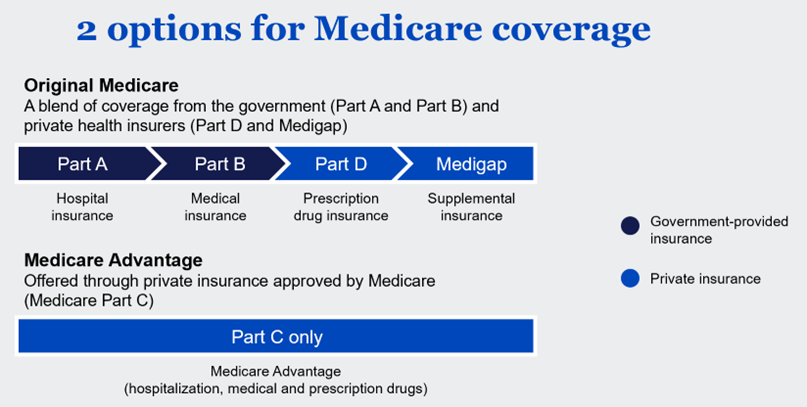Clients are worried about life after retirement: Here’s how you can help
Help retirees flex their financial plans to deal with today’s challenges.

Key Takeaways:
Because Medicare and Social Security can be complex, covering the basics with clients is a good place to start. The chart below gives an overview of each program:
| What it is | Whom it serves | What it provides | |
|---|---|---|---|
| Medicare | A federal health insurance program | People 65 and older (as well as certain people with disabilities, end-stage renal disease, or other conditions) |
Insurance coverage for certain costs related to hospitalization, doctor visits, outpatient care, and other medical expenses |
| Social Security | A federal income program | People 62 and older (as well as families of deceased workers and certain people with disabilities) |
Income to help beneficiaries pay for daily living expenses and other basic needs |
Now let’s look at how Social Security retirement benefits are calculated. The Social Security Administration bases retirement benefits on an individual’s earnings. The amount an individual can receive at full retirement age—anywhere from 65 to 67, depending on birth year—is known as the primary insurance amount (PIA).
The PIA for each recipient is calculated based on the average indexed monthly earnings (AIME) in their 35 highest-earning years (starting the year you reach age 22).1 However, there is a cap on these earnings—known as the Social Security wage base—for the purposes of this formula. The 2023 wage base is $160,200.2 This base is also the maximum amount of income on which Social Security taxes are paid.
For the benefits calculation, the AIME is divided into three “bend points,” which are adjusted each year for inflation. For 2023, the benefit is the sum of these bend-point calculations:
The result of that calculation is an individual’s Social Security retirement benefit at full retirement age. This amount is increased incrementally each month that benefits are delayed after full retirement age—up until age 70.
Of course, just like many other kinds of income, the amount of someone’s Social Security benefit isn’t necessarily the same as the actual payment that hits their checking account. There can be a variety of deductions from Social Security benefits, including federal income taxes and Medicare Part B premiums. The deduction of Medicare Part B premiums from Social Security payments is another reason why your clients should understand Medicare and how it affects their retirement planning.
One of the first things your clients should know about Medicare is that, unlike Social Security, Medicare benefits aren’t “calculated.” In reality, they are composed of certain kinds of medically necessary and preventive health care services. Each individual will take advantage of different Medicare-covered services depending on their healthcare needs and preferences.

Many people don’t realize that Medicare isn’t free. In reality, there are a variety of potential costs involved. That’s why estimating the cost of Medicare (and related healthcare expenses) is a key part of planning ahead for retirement.
In addition to the potential costs of Medigap or Medicare Advantage plans, your higher-income clients may have to kick in premium add-ons for their Medicare Part B or Part D plans. This added premium is called an income-related monthly adjustment amount (IRMAA), and it’s based on each person’s modified adjusted gross income (MAGI) and tax filing status.
Medicare premium calculations, 2023
| Individual tax filers with MAGI | Joint tax filers with MAGI | Income-related monthly adjustment amount (IRMAA) B+D | Total monthly premium amount |
|---|---|---|---|
| Less than or equal to $97,000 | Less than or equal to $194,000 | $0.00 | $164.90 |
| Greater than $97,000 and less than or equal to $123,000 | Greater than $194,000 and less than or equal to $246,000 | $77.80 | $242.70 |
| Greater than $123,000 and less than or equal to $153,000 | Greater than $246,000 and less than or equal to $306,000 | $196.30 | $211.20 |
| Greater than $153,000 and less than or equal to $183,000 | Greater than $306,000 and less than or equal to $366,000 | $314.40 | $479.30 |
| Greater than $183,000 and less than $500,000 | Greater than $366,000 and less than $750,000 | $432.60 | $597.50 |
| Greater than or equal to $500,000 | Greater than or equal to $750,000 | $472.00 | $636.90 |
Diversifying income outside of the sources above could make a difference in how much your clients pay for IRMAA surcharges on Medicare premiums. Consider these strategies:
To see how some of these strategies could play out, let’s look at an example of how income today can impact IRMAA later.
In 2023, a retiree decides to do a $50,000 Roth IRA conversion. She also receives $30,000 from Social Security and $35,000 from a traditional IRA. Because the Roth conversion pushed her into the next IRMAA bracket with a total income in 2023 of $115,000, she will potentially have higher Medicare premiums in 2025.
She could have avoided this by breaking up the Roth conversion. For instance, she could have spread the $50,000 conversion across two years—converting $25,000 each year. This would allow her to keep her income under the IRMAA threshold.
By helping clients understand how to minimize what they pay for Medicare Parts B and D, you’ll also help them decrease deductions from their Social Security checks. Providing this kind of valued guidance on a topic that’s confusing to many will go a long way toward earning their loyalty and trust throughout their retirement journey.
Clients can get an estimate of their Medicare costs at medicare.gov. And they can log in to their my Social Security account for an estimate of their Social Security benefits.
The Nationwide Retirement Institute® also offers a wealth of insights and resources to help you create smart strategies for your clients. You can find tips and strategies on a broad array of financial topics at NationwideFinancial.com/topics.
“Topic No. 751, Social Security and Medicare Withholding Rates,” Internal Revenue Service, https://www.irs.gov/taxtopics/tc751
“Primary Insurance Amount,” Social Security Administration, https://www.ssa.gov/oact/cola/piaformula.html
“Parts of Medicare,” U.S. Centers for Medicare and Medicaid Services, https://www.medicare.gov/basics/get-started-with-medicare/medicare-basics/parts-of-medicare
“2023 Medicare Parts A & B Premiums and Deductibles 2023 Medicare Part D Income-Related Monthly Adjustment Amounts,” Centers for Medicare & Medicaid Services, Sept. 27, 2022, https://www.cms.gov/newsroom/fact-sheets/2023-medicare-parts-b-premiums-and-deductibles-2023-medicare-part-d-income-related-monthly
Federal income tax laws are complex and subject to change. The information is based on current interpretations of the law and is not guaranteed. Nationwide and its representatives do not give legal or tax advice. Please consult an attorney or tax advisor for answers to specific questions.
NFM-23282AO